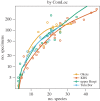An ecometric analysis of the fossil mammal record of the Turkana Basin
- PMID: 27298463
- PMCID: PMC4920289
- DOI: 10.1098/rstb.2015.0232
An ecometric analysis of the fossil mammal record of the Turkana Basin
Abstract
Although ecometric methods have been used to analyse fossil mammal faunas and environments of Eurasia and North America, such methods have not yet been applied to the rich fossil mammal record of eastern Africa. Here we report results from analysis of a combined dataset spanning east and west Turkana from Kenya between 7 and 1 million years ago (Ma). We provide temporally and spatially resolved estimates of temperature and precipitation and discuss their relationship to patterns of faunal change, and propose a new hypothesis to explain the lack of a temperature trend. We suggest that the regionally arid Turkana Basin may between 4 and 2 Ma have acted as a 'species factory', generating ecological adaptations in advance of the global trend. We show a persistent difference between the eastern and western sides of the Turkana Basin and suggest that the wetlands of the shallow eastern side could have provided additional humidity to the terrestrial ecosystems. Pending further research, a transient episode of faunal change centred at the time of the KBS Member (1.87-1.53 Ma), may be equally plausibly attributed to climate change or to a top-down ecological cascade initiated by the entry of technologically sophisticated humans.This article is part of the themed issue 'Major transitions in human evolution'.
Keywords: ecosystem change; fossil mammal; human origins; palaeoclimate; predictive modelling.
© 2016 The Authors.
Figures










References
-
- Coppens Y, Howell FC. 1976. Mammalian faunas of the Omo Group: distributional and biostratigraphic aspects. In Earliest man and environments in the Lake Rudolf Basin (eds Coppens Y, Howell FC, Isaac GL, Leakey REF), pp. 177–192. Chicago, IL: University of Chicago Press.
-
- Leakey MG, Leakey RE (eds). 1978. Koobi Fora research project, vol. 1. The fossil hominids and an introduction to their context, 1968–1974. Oxford, UK: Clarendon Press.
-
- Harris JM (ed.). 1983. Koobi fora research project, vol. 2. The fossil ungulates: Proboscidea, Perissodactyla, and Suidae. Oxford, UK: Clarendon Press.
-
- Harris JM. (ed.). 1991. Koobi fora research project, vol. 3. The fossil ungulates: geology, fossil artiodactyls, and paleoenvironments Oxford, UK: Clarendon Press.
-
- Eck GG, Jablonski NG, Leakey M. 1987. Les faunes Plio-Pléistocènes de la basse vallée de l'Omo (Éthiopie). Tome 3: Cercopithecidae de la formation de Shungura. Paris, France: CNRS.
Publication types
MeSH terms
LinkOut - more resources
Full Text Sources
Other Literature Sources
